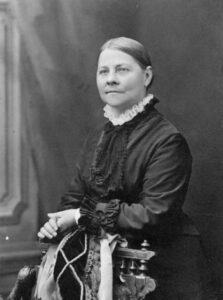Meet Lucy Stone

Alright, blog #2! So, if we’re going on this fun-filled journey discussing all the different married name choices, we first have to talk about, and give credit to, the first woman who fought to keep her maiden name after she got married – Lucy Stone.
Today, American women and men, have so many different options when it comes to choosing a married name, but that wasn’t always the case. The Coverture laws brought over from Europe basically said that when a woman married, her legal existence merged with her husband’s existence, so that she had no independent legal existence of her own. He subsumed all of her property, including her children and the money she brought into the marriage, and she assumed his name. Her only identity after marriage was Mrs. John Doe, or whatever her husband’s name was at the time.
So, along comes Lucy Stone who says – no way am I getting married and losing all my rights. Lucy, born August 1818, was a prominent U.S. orator, abolitionist, and suffragist, and a vocal advocate and organizer promoting rights for women. In 1847, Stone became the first woman from Massachusetts to earn a college degree. She spoke out for women’s rights and against slavery.
Lucy was doing what she loved to do when Henry Browne Blackwell saw her give a speech – later known as her “fugitive mother” speech – at an antislavery meeting in New York in May 1853. He was enamored by her and wanted to be with her all the time.
Henry, born May 1825, was an American advocate for social and economic reform. He was one of the founders of the Republican Party and the American Woman Suffrage Association.
Henry convinced Lucy to go on a couple of dates with him, but when he proposed, she turned him down big time. There was no way she was going to surrender control over herself or stop doing the work she loved, nor was she going to give up ownership of her property or the rights to money she made.
Henry, determined to convince Lucy that his belief of marriage wouldn’t require her to sacrifice her individuality or career, reasoned that a marriage based on equality would enable each of them to accomplish more than they could alone. She still said no.
After years of pursuing, Henry finally won Lucy over by personifying the belief that couples could shape their own marriages, regardless of society’s laws. Yay! Happy romantic ending.
Immediately after their marriage, with Henry’s support, Lucy continued to sign correspondence as “Lucy Stone” or “Lucy Stone – only.” But during the first summer, Henry tried to register the deed for property Lucy purchased in Wisconsin, and the registrar insisted Lucy sign it as “Lucy Stone Blackwell.”
Henry and Lucy took the matter to court. It took eight months to confirm that there actually was no law requiring a married woman to change her name. With that information, Lucy made a public announcement at the May 7, 1856, convention of the American Anti-Slavery Society in Boston declaring her name remained Lucy Stone. This declaration made her the first woman to officially keep her maiden name after getting married.
It took another 126 years for all 50 states in the U.S. to drop all laws preventing women from retaining their birth surnames when they married. Today about 70% of women getting married continue to drop their last name and take on their husband’s name. But, now we have choices – both women and men.
There’s nothing wrong with taking the husband’s name … just as there’s nothing wrong with taking the wife’s name. It’s all about choices.
Peace, Love, and Choices!
Melanie Joy

